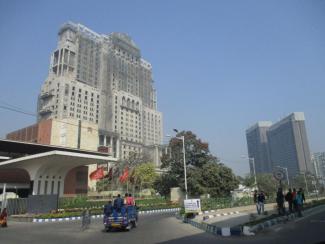Infrastructure
“We need to build shock resilience”
 dem
dem
Why is it so important to limit global warming to two degrees, as was agreed in Paris?
Well, the more temperatures rise, the more chaotic the impacts will be. An increase of two degrees on average implies that humanity must cope with extreme weather becoming more frequent. It will be a challenge, but it can be done. We’ll see more floods, storms and droughts. If temperatures rise even higher, however, we’ll reach tipping points of the geo system. The Gulf Stream may stop, Greenland’s ice shield may melt, or the Monsoon pattern may fizzle out, for example. Such tipping points would trigger unmanageable dynamics. Climate science tells us that an increase of about 2.5 degrees is likely to make Greenland’s ice sheet melt. If that happens, the sea level would rise by seven meters.
So far, our experience has tended to be as bad as the more devastating scenarios indicated. Could Greenland’s ice melt even if global temperatures rise by only 1.8 to 2.3 degrees on average?
That might be the case. Models are always based on assumptions, they help to assess probabilities. If the average rise is 2.5 degrees, there will definitely be serious problems, and a rise of 3.5 degrees would pretty much guarantee the end of the ice sheet. And yes, to date it has been true that the warnings of climate activists mostly become reality faster than was expected. At the same time, the activists were often blamed of fear mongering.
Is it still possible to limit global warming to two degrees?
Yes, it is, but it is a huge challenge. We must almost entirely decarbonise the global economy by 2050. The technologies we need exist or are being developed. We must apply them fast and at a vast scale. In the next decade, we must plan properly, comprehensive new infrastructure must be built accordingly in the decade after that. If that happens, the use of fossil fuels can indeed be phased out by 2050.
According to WBGU research, humankind needs three major transformations to mitigate climate change. The transformations concern energy, urbanisation and land use. What progress is the global energy transition making?
A lot is happening in regard to renewable energies. The costs are going down fast. New investments are hardly being made in other technologies anymore in Europe, for example. The transition is technologically feasible and has become economically attractive. Unfortunately, however, coal is only being phased out very slowly. That is not only the case in Germany, but in China, Indonesia, South Africa and other countries as well. On the upside, the international debate on mobility has gained momentum in recent months. On its front page, the London-based magazine The Economist recently declared the internal combustion engine to have become a victim of “roadkill”. The diesel scandal may thus actually help us to move on to more sustainable transport systems fast.
What about urbanisation – is the buzzword “smart city” important?
To date, that is a trendy term that basically makes the interesting promise of applying information technology in clever ways so we can use infrastructure more efficiently and build more efficient infrastructure. Decentralisation and digitisation certainly make sense. What worries me, however, is that we are hardly making progress in regard to construction and building materials. If humankind keeps using concrete, steel and aluminium at the current rate to build cities, we will be unable to keep global warming below two degrees. The reason is that construction alone would use up the emissions budget that leads to a 1.5 degree increase. Unfortunately, this important challenge is hardly being discussed at the international level.
How do you assess the land-use scenario?
In regard to stopping deforestation, we have turned in the right direction and are moving ahead. It would be possible to stop deforestation by 2030. Unfortunately, there are some setbacks in some countries. Brazil’s current crisis of governance has been harmful, for example. In regard to climate-friendly agriculture, however, not much has happened. The carbon-intensity of agriculture has hardly changed.
Will the political will to drive change in all relevant fields prove sufficiently strong?
Well, the Paris agreement provides a sensible framework for action, and to date, it has not failed. When US President Donald Trump announced his nation’s withdrawal from the agreement, I was afraid he might trigger a kind of domino effect. Had two or three other leaders endorsed his stance at the G20, for example, the Paris agreement would have unravelled. Joining him might have seemed attractive to Russia and Saudi Arabia, for example. The good news is that Trump did not find a partner. Alliance building is not his strong point.
How do you assess the political will in China and India? In absolute terms, the two countries are now the world’s largest and third largest emitters of greenhouse gases.
A positive side effect of Trump’s climate denial is that the Chinese government sees a chance to assume a role of global leadership. That suits its geostrategic aspirations as well as its ambitions for exporting goods. At the same time, it fits the leaders’ insight that unmitigated climate change will wreak havoc in the People’s Republic. China will definitely do its best to bring international climate policy forward. That said, phasing out coal is an urgent issue for staying within the two degree limit, just as it is in Germany.
What about India?
Well, India’s domestic debate has turned a corner since the Paris summit. In the past, leaders in Delhi basically said: we are a poor country and we are victims of climate change, so mitigating the phenomenon would overburden us. Mitigation was seen as the rich world’s job. That has changed. Today, India accepts its responsibility in climate matters and is grasping the opportunities of renewables.
Without contributions from the USA, the other advanced nations will struggle even more to come up with the money they have promised. In Copenhagen in 2009, they pledged that they would make an annual $ 100 billion available for climate mitigation and adaptation in developing countries and emerging markets from 2020 on. How that is to be done, remains an open question.
Yes, that is true, and this debate must be held at the next conference of parties in Bonn in November. In the mid-term, the contributions of developing countries and emerging markets to multilateral climate action will depend on that sum being made available as promised. To date, we lack tangible proposals for schemes. We need to know, however, how much funding governments will contribute and how much the private sector is supposed to mobilise. Moreover, the debate on taxing carbon emissions should resume.
The rich nations have promised to provide climate finance on top of official development assistance (ODA). Along with the UN Framework Convention on Climate Change and the Convention on Biodiversity, this principle was one of the many results of the Earth Summit in Rio de Janeiro in 1992. Donor agencies, however, seem to focus ever more on climate issues.
Donors’ global ODA amounted to $ 140 billion in 2016. So far, climate action is not happening at its expense. Nonetheless, it is essential that the $ 100 billion are indeed additional. Anything else would undermine the trust of the most vulnerable countries. In terms of tangible action, however, it does not make sense to distinguish climate policies from development policies. If measures to reduce poverty compound climate problems, they are obviously unsustainable. At the same time, attempts to protect the climate by further marginalising the poor would undermine the principles of sustainable development.
Climate models tell us roughly what will happen in world regions, but it is impossible to predict exactly what impacts will affect any particular place. Is adaptation possible without such knowledge?
We need to build shock resilience. For example, farmers need seed and plants that cope with a broader range of little to massive precipitation, for example. We also need water infrastructure with retention basins to store rain water and minimise flooding. The same reservoirs will, of course, prove useful in the event of droughts. We must build infrastructures that withstand and absorb possible shocks. In regard to the rising sea level, we have much more precise information, however, and we should protect coasts accordingly.
Dirk Messner advises Germany’s Federal Government as co-chair of the Advisory Board on Global Change (WBGU – Wissenschaftlicher Beirat Globale Umweltveränderungen) and as director of the German Development Institute (DIE – Deutsches Institut für Entwicklungspolitik).
dirk.messner@die-gdi.de




